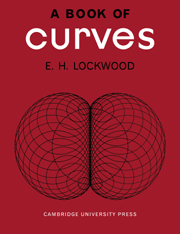Book contents
- Frontmatter
- Contents
- Dedication
- PREFACE
- HISTORICAL INTRODUCTION
- NOTATION
- PART I SPECIAL CURVES
- PART II WAYS OF FINDING NEW CURVES
- 14 Conchoids
- 15 Cissoids
- 16 Strophoids
- 17 Roulettes
- 18 Pedal Curves
- 19 Negative Pedals
- 20 Glissettes
- 21 Evolutes and Involutes
- 22 Spirals
- 23 Inversion
- 24 Caustic Curves
- 25 Bipolar Coordinates
- FURTHER READING
- GLOSSARY
- INDEX OF NAMES
- INDEX OF SUBJECTS
- Frontmatter
- Contents
- Dedication
- PREFACE
- HISTORICAL INTRODUCTION
- NOTATION
- PART I SPECIAL CURVES
- PART II WAYS OF FINDING NEW CURVES
- 14 Conchoids
- 15 Cissoids
- 16 Strophoids
- 17 Roulettes
- 18 Pedal Curves
- 19 Negative Pedals
- 20 Glissettes
- 21 Evolutes and Involutes
- 22 Spirals
- 23 Inversion
- 24 Caustic Curves
- 25 Bipolar Coordinates
- FURTHER READING
- GLOSSARY
- INDEX OF NAMES
- INDEX OF SUBJECTS
Summary
Definition of a Pedal Curve
If S is any curve and O is a fixed point (called the pedal–point), the locus of the foot of the perpendicular from O to a variable tangent to the curve is called the pedal of S with respect to O.
The cardioid and limaçon are pedals of a circle with respect to a point which does or does not lie on the circumference. The pedal of an ellipse with respect to one of its foci is the auxiliary circle (p. 13); the pedal of a rectangular hyperbola with respect to its centre is a lemniscate (p. 112).
To Draw a Pedal Curve
If the original curve has been drawn as an envelope the pedal can at once be plotted as a locus. (A set square may conveniently be used.) A curve geometrically similar to the pedal curve may be drawn as an envelope, as follows: With centre at any point Q of S, and radius QO, draw a circle: the envelope of such circles will be a curve similar to the pedal curve, on double scale. This curve is called the orthotomic of S with respect to O. The method was used for drawing the cardioid (p. 35), the limagon (p. 49) and the lemniscate (p. 112).
It may be noted that, with the pedal–point as origin, the angle φ between the radius vector and the tangent is the same for corresponding points of the pedal and the original curve. (See p. 14.)
Information
- Type
- Chapter
- Information
- Book of Curves , pp. 153 - 156Publisher: Cambridge University PressPrint publication year: 1961
